14th November 2021
Bernard’s Block No. 22
Stepping out with the dog on a dewy morning recently the churchyard hedges were draped with translucent wisps of gossamer glinting in the sunlight. Sometimes they converge to make shimmering, sheets which ripple in the light breeze. They are impressive, not least because they are evidence of the sheer abundance of spiders. These tiny arachnids belong to the family we commonly call money spiders, and were recorded in 1824 by Charles Darwin when aboard HMS Beagle when he noticed the air full of drifting silk threads. Huge numbers of ‘little aeronauts’ were invading his ship, landing on its rigging and scurrying around,
Looking closer he saw that they were small reddish -brown spiders, not only settling, but also taking off again into the breeze. This experience is known as ‘ballooning’ and is what we see in the churchyard on these dewy mornings. The quantity of minute insects they entrap are needed to keep themselves nourished, but the strands help the young spiders, which are most abundant at this time of the year, escape from their cannibal siblings and set up home in a less crowded area. But first the spiderlings need to get airborne by climbing the hedge, facing into the breeze, tilting their abdomens skywards and from their spinnerets exude a thread of silk to lift them aloft on the wind.
The morning sun also lights up the classic autumnal, delicate geometric web of the female garden orb spider spread between two dew laden holly branches. The concentric patterns are arranged like threads drooped across the spokes of a wheel but are unlikely to last more than a few days, before becoming so damaged that the spider must spin a new one.
Autumn has arrived and I recently had the joy of taking two enthusiastic groups of St John’s School Eco Group around the churchyard to explore the new season’s subtle charms of new colours. We fed and identified the regular birds at the feeder stations and tried to identify their calls. We had a great Q&A session as we moved around the churchyard filling in check lists and taking ‘brass’ rubbings at the Lloyd memorial but the fungus spotting was a highlight.
Jewels amongst the grass. A large mass of toadstools has appeared overnight around the Irish yews and the tiny yellow stalks Clavulinopsis), sprouting from some short grass by the path and the scarlet head of a Waxcap beside a headstone ticked several boxes on the ‘eco group’ check sheets.
in the centre of the churchyard is an Ash tree and its prolific number of seeds, each shaped like half a sycamore seed with a similar ability to spiral on the breeze. We spoke about seed dispersal. Let us hope the tree does not become a victim of a new disease called ash dieback that seems to strike at other ash trees locally. Churchyards are one of the few areas left which have escaped the pressures of modern farming or development and artificial fertilizers. They provide therefore, ideal havens for wildlife and wildflowers. They are also home to a variety of bats, birds and butterflies and the more mysterious fungi. It is likely that St John’s churchyard has never been ploughed, fertilized, or sprayed with herbicide or fungicide and therefore represents a relic of former ‘unimproved’pasture which supports this haven. It is here for us all to enjoy and escape the pressures of everyday worries.There are numerous benches where you can stop to watch and listen, but as you wander be aware that some of the old stones are sinking softly into the hallowed turf and becoming unstable. When identified these are marked with blue and white tape and their stability is monitored and if graves begin to sink, the ground becomes uneven, so walk with care but enjoy this wonderful amenity around our church.
BM.
7th August
Bernard’s Blog No.14
The beginning of August is Lammas, or if you are Irish, ’lughnassa’. From the Saxon Leffmessday meaning loaf mass it is the traditional time for cattle to be returned to the hay field to graze the aftermath of hay mowing. It is another reason for a ritual feast and dance. It was traditional to cut a blessed loaf into four quarters and place each of them in the corners of the barn before bringing in the crops.
August can be a quite month for wildlife. For birds the breeding season is over now, birdsong is almost silent and many birds are hiding away to moult and replenish their energy reserves before migrating or to prepare for the winter. The blackbirds and other garden birds seem to have deserted us but they haven’t gone away. Now that the young birds have fledged, the parents are looking understandably worn out having carried beakfuls of worms and other food to their nest-sites over the past few weeks. So, they rest and grow new feathers while there’s shelter from summer leaves and plenty of ripening fruits and insects to feed on and the food we put out on bird tables and feeders sometimes goes untouched. They become inconspicuous for a time as they may be more vulnerable to predation during their moulting period. Generally, moult will not overlap with other processes which are a drain in a bird’s energy, such as breeding or migration. There’s not much song – the garden and countryside can be eerily quiet – and few birds to see. What’s more, when birds do appear, they can look quite strange – yellowish blue tits, blackbirds with speckled heads, brown-headed starlings. This year’s young are losing their first feathers and moulting into their adult coats.
It is a good time however to see the Jays who go into a frenzy of acorn-gathering and it is thought they can hide up to 5,000 in a season, transporting them in their gullet to be buried and eaten later. They are good at finding them again, even in snow, but when you go wandering across a summer parkland, you may come across a tiny oak sapling far from the nearest tree, it’s the one the Jay forgot.
Some of our new planting for the planned Biblical trail will need a season to establish their growth and will benefit and look better after a shower or two, but….
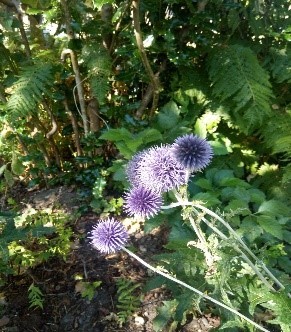
The Globe Thistles (Ecinops ritro) are already looking impressive in the bed in the memorial garden. Stunning spikey deep blue flowers of two inches on three- foot stems are often used in flower arrangements. Numerous references to thistles occur in the Bible from Genesis, Job, Proverbs and other books.
At this time of year, colonies of our common Black Ant are on the move. They produce huge numbers of large-winged virgin queens and smaller winged males all called alates. This is the mating season and the flight is a mechanism to ensure not only that colonies can establish elsewhere, but also reduce the chance of inbreeding. The flight requires clear weather since rain is disruptive for flying insects. Different colonies of the same species often use environmental cues to synchronize the release of males and queens so that they can mate with individuals from other nests, The actual “take off” from the parent colony is also often synchronized to overwhelm their predators. The young mated queens land and, in the case of most ants and all termites, remove their wings. They then attempt to found a new colony. So, if the conditions are right, on just a few days each year (usually when you have a picnic in the garden or are watching a tennis match!) there is an explosion of flying ants from beneath paving slabs

or cracks in the path, off to found a new colony. Not many insects get a mention on the weather forecast but a few weeks ago the Met Office reported with a video that a cloud of ants was picked up moving eastwards on their weather map radar and was mistaking them for raindrops. ‘Mummy ant’
Yarrow (Achillea) grows in grass and on wasteland and you can find it creeping through lawns and the churchyard this month. Its been here since June and will flower through until later in November. It looks a
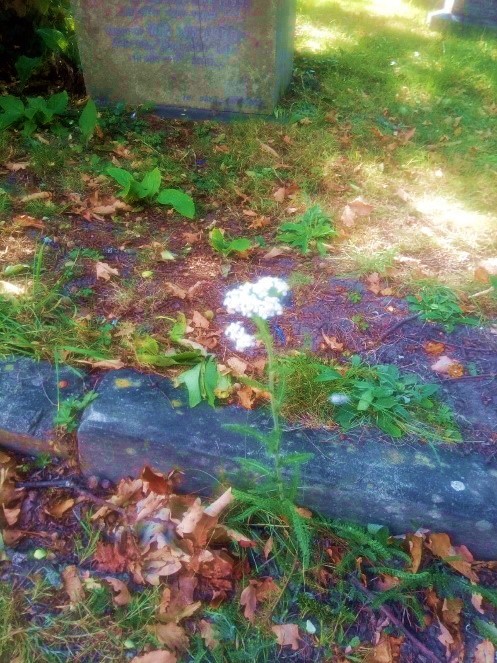
little like Cow Parsley with white clusters of flowers and dark green, feathery leaves. Don’t dismiss it as another weed as it has a historic story and a reputation as a healing herb. Its Latin name Achillea millefolium, honours Achilles, warrior and healer of Greek mythology, who taught his men to use the plant to staunch wounds on the battlefield. It is also known as the milfoil, or thousand leaf, and its medicinal qualities are supported by science as well as myth. So, when you see it flowering at St. John’s, think how it once flowered on the war-torn plains below the walls of Troy.
For the past few years, we have had enquiries in the churchyard, usually in the autumn, about “What are those large white balls in the grass?”
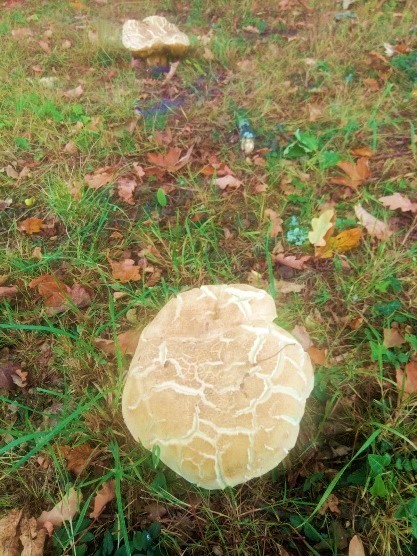
They are back early this year- Giant Puff Balls, an amazing fungus. The fruit bodies’ up to 30 cm diameter have a smooth white, leathery texture and have appeared opposite the porch and near the Ruskin tomb. This year they are beside the Tamberlin room but don’t be tempted to give them a kick or a prod they will release microscopic spores into the air. The interior is initially white and fleshy becoming yellowish as they mature and turn to olive brown. Attachment to the soil is by means of a tiny cord, and mature fruit bodies often become free and get blown by the wind scattering spores in the process. They won’t be here for long but will no doubt be back next year.
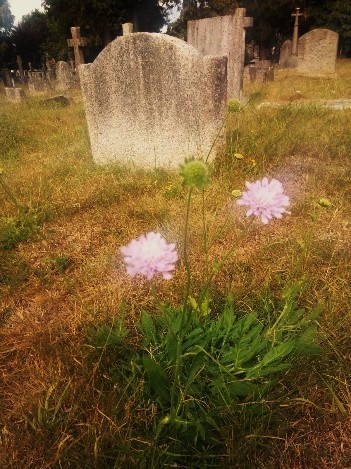
Standing alone between the Lloyd memorial and the hedge is a Field Scabious. It is the sky-blue flower of late summer with a broad, flat flower head made up of many little flowers, each sitting atop a rough, hairy single stem. The leaves are variable, some deeply lobed, others unlobed. This one is the only one I found in the churchyard whilst hunting for the grave of a famous ‘penny-farthing’ cyclist. But that’s another story.
Bm
24th July
Bernard’s Blog No. 13
I have had a few days away with my daughter in Shipston on Stour in The Cotswalds. A beautiful part of the country and an opportunity to find new ‘Blog’ material. Shipston is a small market town in Warwickshire, The towns name derives from being known in ancient times as ‘Sheep-wash-Town’. Shipston was for a long time an important sheep market town and after the demand for local wool began to diminish the town continued to flourish thanks to the opening in 1836 of a branch line from the horse-powered tramway built a decade before to link Stratford with Moreton-in-Marsh. The line became a modern railway in 1889. The town was also an important coaching town and many of the inns from that era survive in the area of the High Street. Shipston was a working Wool Town and developed many woollen skills, including those for making tapestries including the famous Sheldon Tapestries in the neighbouring farming hamlet of Barcheston. which became central to the history of English tapestry making. It is today officially commemorated by the ‘Wool Fair’ which usually takes place on Spring Bank Holiday Monday but was not held this year due to Corvid restrictions. It was a walk with Bertie that drew my attention to the many Teasel flowers along the riverside and reminded me that Teasels were once used when their flowering heads were dried for ‘teasing’ apart strands of wool and for combing the nap of fabrics. including the baize used on billiard tables.
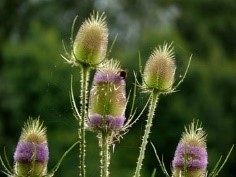
In the textile industry, clusters of the flower heads would be fixed to frames for this purpose. This month they are in bloom, their spiny stems topped with purple spiralling globe-shaped spiked flower heads, and the hum of bees. In the autumn the goldfinches will be back to feast on the seeds.
Back in Shirley, our churchyard maintenance contractor has spent a weekend tidying and cutting the boundary hedge and will be taking a huge quantity of trimmings away in the next few days. He has almost completed the planting of the additional ‘Biblical reference’ plants for the trail we have planned and we can put the finishing touches to the booklet which will indicate where to find a ‘Burning bush’, ‘Fig Tree’, Passion flower’, ‘Olive Plant’ or ‘Judas Tree’ and many others.
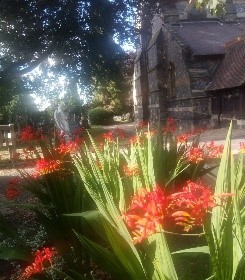
As you come through the lych gate, on your right is a clump of Crocosmia (Montbretia) in full flower.
The vivid red flowers are coincidentally and aptly called ‘Lucifer’, so this will go into the booklet. The ‘June gap’ between spring and summer butterflies is over and the high summer species begin to appear in force. The Buddleia at the south east wall of the chapel is in flower and the long sausages of purple, fragrant flowers are a magnet for butterflies and bees. It is time I consulted my butterfly buddy Neil for some identification advice. It only took one phone call and twenty minutes later he was beside me, book in hand. It was sunny and warm and as we moved from the lych gate to the west of the churchyard we immediately saw ‘a little brown one’ as I pointed out to him. “A Gatekeeper” he thought and correctly confirmed it from his book. The Gatekeeper was once known as the ‘hedge brown’, and got its current name from the habit of basking near gates and stiles. The grass here is quite short, so the ground is marginally warmer, enabling the insect to get to its optimum temperature for flying more quickly, as it did. Gatekeepers are smaller, brighter and more attractive than
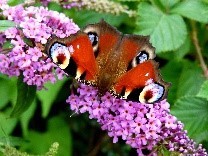
some of its cousins we saw that day. The next little brown one was a Meadow Brown last seen by me in Dorset, but one of the most widespread butterfly species. We spent a wonderful peaceful part of the morning moving around between the headstones and noted ‘Small white’, ‘Large white’ female ‘Brimstone’, ‘Red Admiral’, ‘Peacock’ (on the buddleia. See pic.)’ Small Copper’ .On a subsequent visit I noted a Common Blue and a Comma. We also spotted a Dragonfly and several grasshoppers * but got rather depressed when we saw The Parakeets stripping the berries from our Mountain Ash so deciding we needed a coffee and departed. It was a lovely way to spend an hour and we agreed to return soon.
“Butterflies can’t see their wings, they can’t see how truly beautiful they are, but everyone else can. People are like that as well”
Naya Rivera
Thank you Sharon for the quote
*Grasshoppers are among what is probably the most ancient living group of chewing herbivorous insects, dating back to the early Triassic around 250 million years ago. Sixty -five million years ago, when a huge asteroid-induced extinction event killed 95 percent of living things on Earth, these were one of the creatures that survived. Grasshoppers have had a long relationship with humans. If you can gently catch one, look closely at these little locusts. It is easy to believe that they are ancient creatures mentioned in the Bible. Swarms of locusts can have devastating effects and cause famine, and even in smaller numbers, the insects can be serious pests. They are used as food in countries such as Mexico and Indonesia. They feature in art, symbolism and literature.
They make the familiar buzzing sound, a constant accompaniment to long hot summer days and muggy evenings, using a process called stridulation- rubbing a rough leg across their wings. As naturalist Andy Beer says “It is the soundtrack of summer.”
7th July
Bernard’s Blog No. 12
I shared a Bertie dog walk with one of my (grown-up) granddaughters last week. I suppose it’s the generation gap but I often relate stories and anecdotes to her which she loves, particularly songs or poems I recall from my childhood and which she has never heard before. She had earlier bought some petunias to plant in a flower bed and I sang to her “I’m a lonely little petunia in an onion patch”. “You’re making it up”, she said so I suggested she asks “Alexa” to play it as that seems to be the current source of her music requirements. On today’s walk we were joined by another of my (grown-up) granddaughters and our walk took us through the churchyard where we did some wild flower spotting. What’s that pretty bell-shaped flower?” was identified as Field Bindweed (Convolvulus arvensis) in a large mat beside the footpath. I
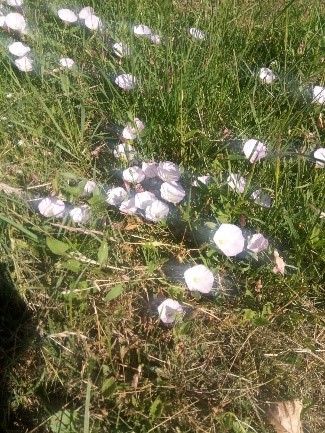
explained it was a Bindweed whose stems coiled anti-clockwise as opposed to the Honeysuckle we passed by the gate on the way in, whose stems coiled clockwise. “How do you know that?” they asked. So, I sang some of the Flanders and Swan song “Misalliance” about the unrequited love of the two flowers. We had to ask ‘Alexa’ to play that when we got home as I could not remember most of the words.
The Field Bindweed is a pink or white striped trumpet shaped, scented flower with arrow shaped leaves. Its big cousin is the Hedge Bindweed (Calystegia sepium) also flowering at the moment with larger, white trumpets that are visited at dusk by Hawk Moths. The bind with Bindweed of course is that as a weed is can rapidly take over a garden if not checked: its deep-running brittle roots are almost impossible to eradicate. There’s an irony in that the same gardeners that wage war on it will cherish the tender blooms of its relative, the Morning Glory. The Bindweed has one of the largest single blooms of any British wild flower and the virginal trumpets are a favourite with Bumblebees whose furry bums are all you see as they nose into the flower’s extremities for nectar. The deep well-like blooms are gloriously described by botanists as ‘infundibuliform’- shaped like a funnel. Have you ever watched a Bumble bee struggling to reverse out of a Foxglove bloom, looking as if it had been ‘flour-bombed?
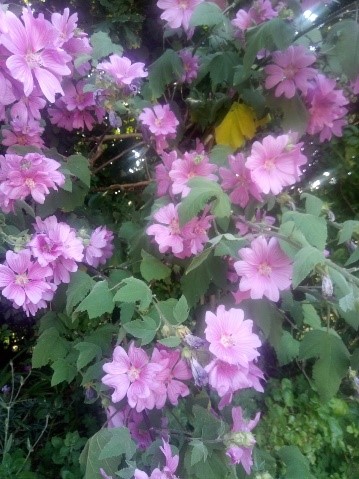
Along the west boundary of the churchyard the greenery of the shrubs is brightly punctuated by the woody stems of the Common Mallow (Malva sylvestris) sometimes called “Lavatera” The rose-purple blooms with their dark-striped petals brighten up the border and are climbing high into the trees. The leaves, stems, fruits and seeds are all edible, although Job in the old Testament book (6.6-7) was not impressed and thought them ‘tasteless, they are as food that is loathsome to me ‘. The round seeds in a circle of nutlets look like little loaves of bread, and during the siege of Jerusalem in 1948, one species of mallow played an important role. Mallow soup, rich in iron was one of the dishes cooked by the Jewish people in order to survive.
When we strim the grass between the headstones in the churchyard the shortened areas of grass provide good foraging places for visiting Green Woodpeckers (picus viridis). These are the largest of the three British woodpeckers which nest probably in trees in the adjacent woods and can usually be heard before being seen. The greater and lesser spotted woodpeckers make a loud rat-a-tat as they use their sharp beaks to chisel into the bark of a tree in search of insects. They grip the trunk or branch with sharp claws and thrust their tails stiffly against the bark to prop themselves up and give a powerful blow with the beak. In the spring, they make a drumming noise with their beaks on a piece of wood as part of their courtship. The green woodpecker however, seldom drums and visits St John’s patches of open ground in this season, as they feed on the ground insects, predominantly ants by probing the ground and drawing them up with a long sticky tongue. The birds have a loud unmistakeable laughing call known as a ‘yaffle’ which they employ as they fly away in a distinctive looping flight if disturbed.
The ‘Yaffle’ is the old country name for the Green woodpecker and has a folklore association as the ‘rain bird’; in France it is still called pic de la pluie and its mocking cry is known to herald the storm
Lorsque le pivert crie
Il annonce la pluie
It also has a place in Roman (sacred to the God Mars) and Greek mythology.
Many of the plots within the churchyard were surrounded by kerbstones which marked the boundary of the grave space. This often left very little room between adjacent graves in a churchyard becoming increasingly full. It also made maintenance difficult and cutting the grass often resulted in damage to the mowing machines when they hit the stones. Eventually in 1978 the PCC obtained a faculty allowing the removal of kerbstones and conversion to a “lawn cemetery” so that cutting of grass could be done by machines. Where kerb stones bore inscriptions of names and dates, they were reset in the ground side-by-side as you will notice as you walk around the site. Plain kerbs were often reused to create raised beds for planting, or to support soil banks.
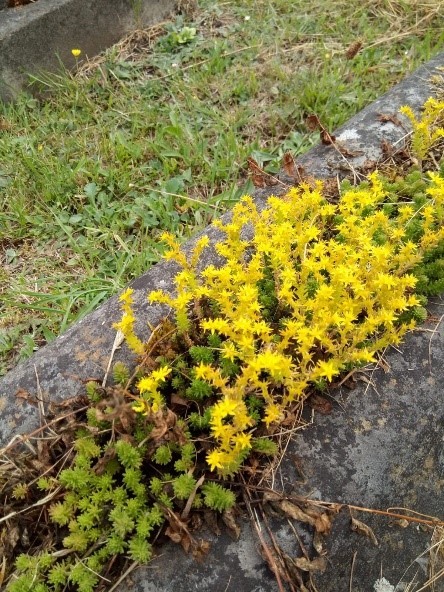
Between the re-laid stones wild flowers found a new home. Rock may seem an inhospitable habitat, but there are a number of species both wild and naturalized, which readily colonise the stone habitats that are so plentiful in churchyards. The common Houseleek thrives on paved areas and also on roofs of porches, sometimes on lych gates. Sometimes it is planted, since it is traditionally thought to bring good luck and protect against lightning.
Another is the Biting Stonecrop (Sedum acre), whose bright yellow flower heads make umbrellas above the dense mat of leaves, pictured here. It gets its name from the burning taste of its small fleshy leaves
It is pleasing to see that St John’s is supporting several types of Ferns and Lichens. More than half the British species of lichen (pronounced ‘liken’ not ‘litchen’) grow on stone, so with very little natural outcrops of rock in this area, a churchyard will provide the only significant area of old permanent stonework on which they can grow. St. John’s like most churches is built on an east-west axis, so the walls face more or less due north, south, east and west and each aspect has its own types of lichen flora in an astonishing variety of shape, size, form and colour. Unlike most plants and fungi, they appear the same all year round. So this will need more research to keep me amused but basically it is good to note the state of health of lichen flora is related very close to the quality of the air, the standard test for air pollution is the presence or absence of certain lichens, since different species are quantifiably more or less sensitive to sulphur dioxide. Next time you pass or go through the lych gate, look up at its roof, you will see some good examples of lichen.
Flanders and Swan song “Misalliance”
25th June
Bernard’s Blog No. 11
Inevitably my morning walks with the dog take me through the churchyard and Bertie’s afternoon stroll usually follows a similar route. It is a rich source of interest in the flora and fauna with its diversity of habitat there. This is not a condition brought about by natural causes. The special things we take account of in a churchyard – the boundary walls and hedges, the mature trees, the variety of grassy spaces, the memorials – have not arrived there accidentally; they are the result of a long interaction between human and natural history. Let me take you back a little to some of St. John’s history:
In the year 1834 the Hamlet of Shirley, although a wealthy neighbourhood and close to the Archiepiscopal Palace of Addington, had no place of worship whatever. It was then that the Vicar of Croydon, the Rev. H Lindsay, realising Shirley’s great distance from the mother Church, determined, with the aid of a few friends to supply the urgent religious needs of the district. A small building, where the present Church Cottage now stands, was acquired, fitted up as a school at a cost of £200 and shortly afterwards licensed for divine service by the Archbishop Howley. Here gathered the first Shirley Church congregation who joined in a simple single service each Sunday, conducted by the Vicar of Croydon.
This continued until July 1835 when the first stone of a new Chapel was laid. Lord Ashburton had given three acres of land to the west of the school as a site for this and a great effort was made to raise the £1,250 required for the new building. On 22nd April 1841 the Rev. Matthew Farrer, who had been officiating as Curate-in-charge of the Chapel since July 1840, was appointed the first Vicar of Shirley.
This was a large site for a church and churchyard and an additional school was completed in 1885 together with two cottages for teachers. However, in 1907 Lord Eldon gave an additional three acres for extension to the site as the churchyard was filling with burials. St. John’s was then and remains a beautiful place, not only much sought after as a place for burial but an oasis of calm where non-churchgoers as well as religious folk are drawn to visit and appreciate nature.
So here I return and find a host of fascinating and enchanting things to talk about.
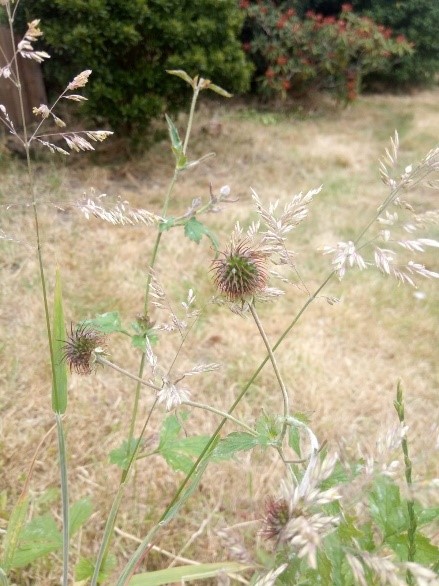
The Burdock plants are losing their thistle-like, red-purple heads and preparing to be a nuisance as the seed clusters form big round burs which will detatch on to your socks and other clothes. When you pull them off think about a Swiss engineer called George de Mestral who was similarly smitten whilst walking in the Jura mountains. Rather than complain about the inconvenience however, he put the seeds under a microscope and a few years later patented a new fastener called Velcro with a name based on the French words for velvet (velour) and hook (crochet), you will the source of his inspiration.
Most of my childhood was spent in South Norwood and I remember behind the Stanley Halls there was a depot for Conona pop drinks. In those glass bottles with the flip over ceramic stopper which were delivered in crates with cash back on the empty returns. The favourite drink was Dandelion and Burdock made I believe from burdock roots. Do you recall those drinks?
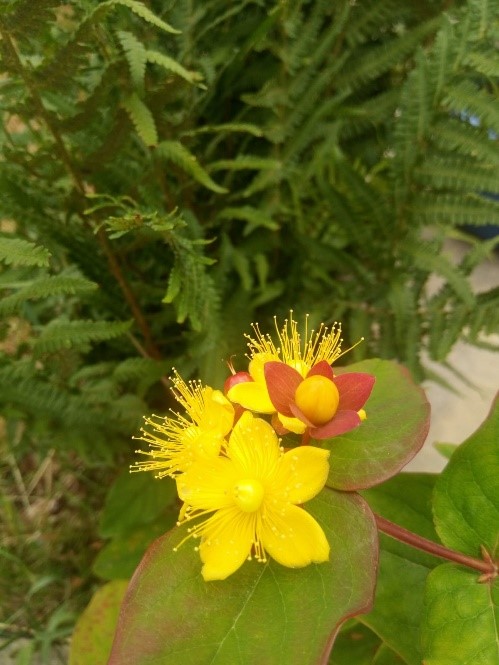
There are a number of plants named after saints, sometimes because the flowering season is around the time of the saint’s feast day. This is the case of Saint John’s Wort (Hypericum), Saint John the Baptist’s Feast Day is officially on 24th June and around this date the St John’s Wort plant is flowering in several places in the churchyard. (don’t be confused however, St John the Evangelist has his Feast Day on December 27th which is during Christmas so we transpose our “Patrons Day” Celebration to the summer.) I suppose it is confusing but the pretty yellow flowers with translucent dots can currently be seen under the east window of church and a few other places around.
We come across many plants with the suffix ‘wort’ attached which were often related to plants with some medicinal property, e.g. Liverwort, Lung wort etc. St John’s Wort had traditional medicinal use with antidepressant properties. The word itself is derived from the Old English wyrt simply meaning ‘plant’.
The additional planting we are undertaking to create a Biblical theme in the churchyard is continuing and most of the plants are settling in well. The vine is showing early signs of fruit, the olive trees have taken well as have the Pomegranate and other plants in the Garden of Remembrance.
The impressive addition so far is the Passion Flower plant which has borne several blooms
There is a symbolism associated with the Passion Flower which relates to the Passion of Christ and you will see the flowers carved into the stone of several memorials in the churchyard.
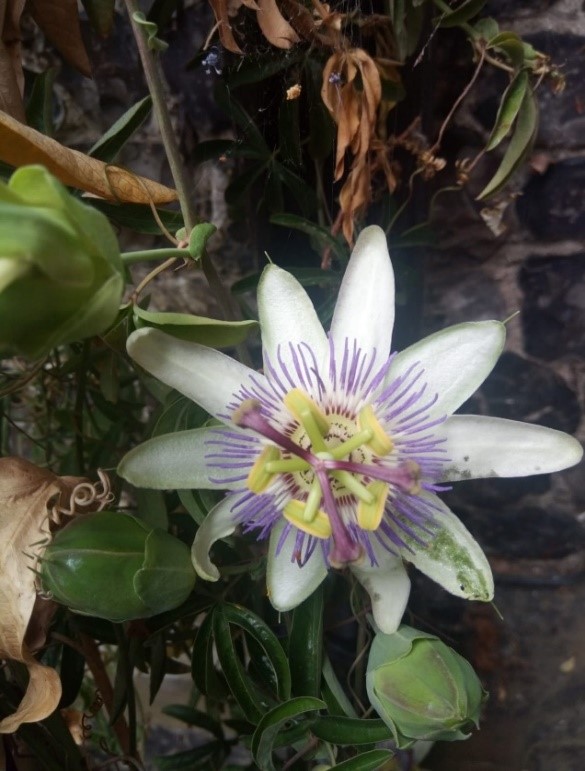
Traditionally the symbolic use of the Passion flower was to help people understand the Passion of Christ and the Crucifixion. It was seen in the following way, ‘The whipping and scourging of Christ is represented by the tendrils. The pillar of the scourging is represented by the flower column. The Crown of Thorns is the 72 filaments that encircle the head. The three nails are symbolized by the top stigma and the five wounds of Christ are the five anthers. The style is the sponge that moistened Christ’s lips with vinegar. The spear blade that pierced his side is seen as the leaves (some species only). The blood of Christ is the red stain from the plant and the round fruit of the plant symbolises the world he came to save. Like the teachings of Christ, the Passion flower has spread around the world carrying the story of Calvary and the Christian message to people far and wide over many centuries.
My regular trips to the churchyard correspond to the topping up of bird feeders and I have a stopping spot on a seat near the gate to St John’s School where there is a feeding station and I catch up on a little bird watching. The last couple of weeks has seen a Robin family use the ‘takeaway’ facility and it is enchanting to see the young birds, with their speckly chests, not yet grown the red feathers. They line up along the top of the Preston memorial which is conveniently close by. This is the Grade I listed memorial in the form of a Greek Temple and the parent birds are frantically busy at most times of the day delivering food into the ever- gaping mouths of the youngsters. There were six of them today and the parents had to share the fat balls with the regular visiting Coal Tits and Blue Tits. I feel now I have a duty to keep them supplied as they have to contend with the marauding squirrels who wreck the feeders I put up to take the seeds. They are quite brazen and work as a team waiting and watching unconcerned until Bertie and I get up from our seat to move on, but we know they will be back. It is, in fact, a wonderful location in the west of the churchyard to spot birdlife. The young Starlings are there in a flock and are not bothered by one man and his dog on the seat and we have had lovely close encounters with a regular Greater Spotted Woodpecker, Jays, Blackbirds and Thrushes. I must report however, the Ring Necked Parakeets are in the trees but thankfully have not yet ventured on to our new spire.
I met with the new horticulturalist from Hall Grange who took me to see the work his team has undertaken in The Wilderness Garden. It is very impressive but not quite ready to have visits from Hall Grange Residents yet. The footpaths are ‘wheelchair friendly’, and when the Covid-19 regulations allow they will be let loose to explore this wonderful amenity. We at St John’s will also be offered the opportunity of tours with the volunteers very soon. The new Gardener, appropriately named ‘Adam’, has agreed to help us maintain the grave of Rev. William Wilks and we hopefully will have Shirley Poppies blooming there again this year.
Adam is keen to reinstate the Kitchen Garden within The Wilderness and has found it mentioned in notes at Hall Grange. Unfortunately, there is no record of its exact location and he wondered if any older members of our congregation can recall seeing it or can help with its location. Please let Bernard know if you can remember it.
bm
13th June
Bernard’s Blog No. 10
Bertie and I are spending quite a lot of time in and around the churchyard since we have returned to Shirley. It has given me a chance to catch up with the new planting and planning being undertaken to enhance the beds and borders into creating a Biblical theme to our plants and trees. In exploring the grounds, we have also been able to appreciate the wildlife and flora with new eyes. Many wildflowers that we may often consider as ‘weeds’ bear closer examination and appreciation. On our morning walk to the churchyard we pass, after a Bertie ‘sniff’, a recess in the boundary wall which used to a shortcut gateway from the original vicarage. This was important to Revd. Wilks as noted by Canon Rawlins, a later vicar at St John’s, who noted that Wilks was sometimes so engrossed in his gardening that he forgot about weddings and funerals and had to be reminded by the verger,
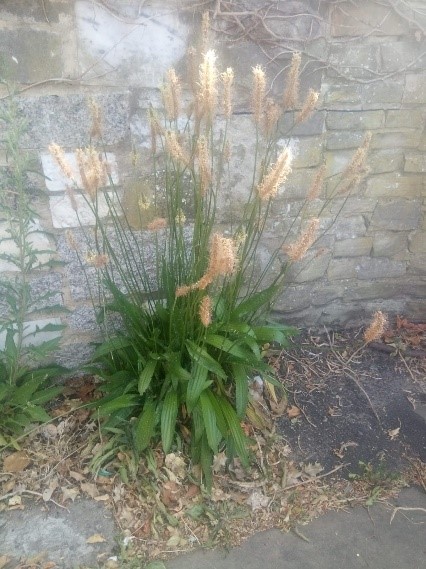
and his housekeeper used to ring the bell in the front garden of the vicarage when service was due to call him across the road with his surplus over his gardening clothes to change out of the boots in the churchyard. But I digress, the recess in the boundary wall has been bricked up since the old gate collapsed but the two large stone balls marking the entrance are still there and I thought it may be of interest why it was there.
It is currently the site of some interesting wild flowers. Apart from the sow thistles and buttercups there is a handsome Ribwort Plantain It has a flat rosette of lance like leaves with several long wiry stems, each supporting a browny-black oval flower head sporting a cream fascinator of flowers.
Moving on and entering through the lych Gate the fragrance of the Woodbine (Wild Honeysuckle) is still very powerful from beneath the notice board.
The contractor has been mowing the paths that criss-cross the site but will not be cutting between the graves for two or three months so the wild flowers will be more noticeable and the butterflies and other insects will flourish. The Ox-eye daisies are standing tall. The children’s petal-plucking game ’He loves me, He loves me not’’ is thought have started with the Ox-eye Daisy. The blooms are so bright they appear to ‘glow’ in the evening giving rise to their other common names of ‘moon daisy’ or ‘moon penny’. The white clover is attracting the bees which use the nectar to produce clover honey. The stems creep along the ground whereas the red clover, now also prominent grows more erect. The path behind the Tamberlin room is fringed with Birds-foot trefoil. This yellow, red tinged flower is an important food source for the caterpillar of the Common Blue butterfly. Which leads me on to a comment I heard that, although June is a vibrant month and the height of the breeding cycle for much of our wildlife, there is often a period when things seem to stall.
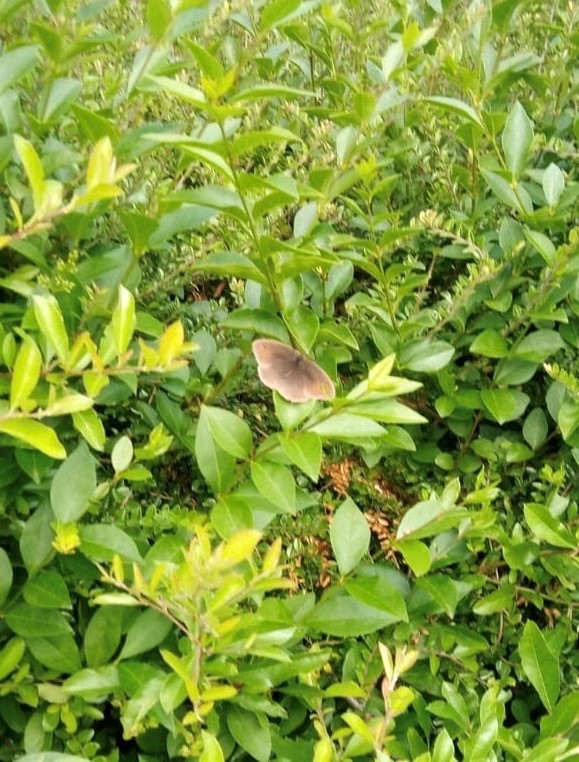
After the onrush of bird migration, the dawn chorus and the spring explosions of insects and flowers there comes a lull. Butterfly experts note this as the ‘June gap’ when the spring broods disappear and the summer generations emerge. My saviour this year appeared whilst walking Bertie in the Shirley Recreation Ground and we spotted a Meadow Brown in the hedge surrounding the locked- up children’s playground. This bobbing brown triangle is evidently one of our commonest butterflies. Easy to overlook but far from mundane, they have an orange flash and large eyespot near the fringe of each upper wing, which may serve to scare a predator away. A butterfly may survive a peck on the wing better than to the body. I consulted my friend Neil, who insists he is more keen than expert. He confirmed the breed but said “There is supposed to be an early surge this year. So early that some may be too soon for their caterpillar food stuff” We will see!
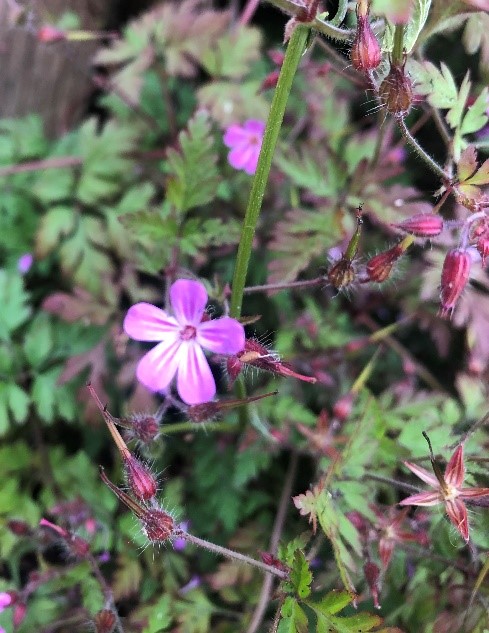
There is a plant that seems to grow anywhere, commonly in shaded areas where it can be a good ground cover but it has a tendency to self -seed and can eject its seeds up to 20ft forcefully from the pod, becoming a nuisance as a garden weed. Luckily it is shallow rooted and can be pulled up from where it is not wanted. It is actually a pretty, bright pink flower with long-stalked deeply dissected leaves and called Herb Robert. It is a member of the geranium family and has beak shaped seed heads so is also known as Common Stork’s Bill one of the ‘cranesbill’ flowers. Look closer next time and as with the Bird’s foot Trefoils, use your imagination to see how it got its name.
I hadn’t seen many Song Thrush over recent years, but noted two different pairs in the churchyard this month. Lu told me she has also spotted them in the vicarage garden. They cock their heads to one side, as if listening but in fact looking for a worm. I haven’t yet found their anvil which they use for snail smashing, and they don’t usually hide the evidence. We have also regular visits from the Jays, they hiddozens of acorns last season and seem to be good at finding them again, even in the snow. An amusing (?) fact is the Latin name for this bird is Garrulus glandarius, which translates as ‘noisy acorn eater’, a great summary. It is good to see a mini -revival of Starlings this year after their numbers dropped over the past couple of years. My wife and I used to call each other (“the boys are back!”) to watch them when the young birds descended on our bird feeder like the children coming out of St John’s school at the end of day, noisy and excited squabbling before heading back to the family nest. Earlier this week we saw thirty together on St John’s School playing field.
I have occupied some of my ‘lockdown’ time preparing a self -guided tree trail around the churchyard. I hope this will prove to be popular with St John’s regulars but will also be interesting and informative to our visitors and can be a useful accompaniment to sessions in the Tea Room or simply a pleasant way to spend time exploring our wonderful facility.
Below is the introductory paragraph. I hope to whet your appetite to take the full trail when we are able to promote it properly.
Bm
St John’s churchyard has numerous mature trees, which are very prominent and clearly visible from the surrounding public highway making a significant contribution to the street scene and appearance of the local area. Venture inside and you will discover a variety of interesting trees, mainly indigenous and some introduced. The site experiences a steady volume of human traffic, visiting the graves, the adjoining school or functions within the church and The Tamberlin Room as well as attending weddings and funerals. However, we welcome visitors to discover the abundance of nature and history awaiting them, several seats are provided in this quiet little area, away from the noise of traffic but surrounded by birdsong. This short guide to the trees will supplement the more detailed list and location of recent planting of flora with a Biblical association. Approximately 50% of the subject trees are situated around the perimeter of the site with the remainder located in and around the central sector and in the Garden of Remembrance. Our planting is in the beds and borders around the churchyard separate from the personal grave plots and is being identified with labels noting the Biblical connection.
29th May
Bernard’s Blog No. 9
Just because an animal is common, doesn’t mean you see it very often. Bertie and I had been wondering if we would see any small mammals on our morning walks and he spends a lot of his time with his nose in the hedges which means ‘walks’ are not usually quick things, but it does give me more time to enjoy the countryside. We hadn’t gone far however, when he sniffed at a rustling beside the garden wall and a small brown rodent appeared and disappeared quite quickly. I thought is was probably a wood mouse but it came back and surprisingly stared at us. Then I noticed its short ears and rounded snout. It was a Field Vole- also known as the short -tailed vole and this chap’s stumpy tail was a giveaway.
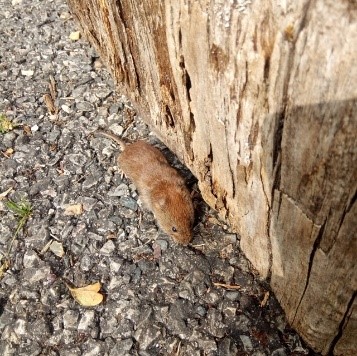
There are evidently more field voles than people in Britain (75m at last estimate) but they all have brief eventful lives with three main aims: to eat, reproduce and avoid being eaten This one was not in any hurry to go however so I snapped it before we moved on.
Our luck didn’t stop there for the Bertie nose led us to a spot where the stream bed was just a damp trickle and another darker furry rodent was scurrying along just long enough to notice a longer tail, very small eyes, short legs and a long pointed nose. A Common Shrew, but not wanting to stay around, so no chance of a picture. Life is fast for a shrew, it is said their heart can beat up to 20 times a second, a faster heart rate than any other mammal on Earth. This is why they are all of a twitch, with busy jerky movements to fulfill their need to eat their own body weight in food each day to survive.
With the slow flowing river and pond nearby we have had visits from Damselflies, looking like multicoloured matchsticks, commomly sky blue and black bodies on the male and green and black females. There is also a red bodied variety. These are much daintier than the true Dragonflies who rest with their wings outstretched, whereas the damselflies wings are folded together over the body.
It was nice to sit out as the afternoon drew into evening and that lovely word ’twilight’ came into its own. That time of two lights, the fading sunset as the sun illuminates the earth’s atmosphere even though it is below the horizon, and the emerging light of the moon and stars. A time to set your eyes on the sky and watch the last of our avian summer guests arrive. Jet black and scything, lightening fast through the sunset, a screaming flock of the unmistakable anchor shaped Swifts, chasing each other as they catch flying insects for food. They are masters of the air, having spent the winter months in sub-Saharan Africa they place their nests in man-made structures when breeding, often in loft spaces and church roofs. Otherwise they are not creatures of the earth, but mystical dwellers of the air spending their entire life on the wing, feeding, sleeping and mating and at night spiralling upwards miles above our heads in the dusk, until they can no longer be seen or heard, for a gliding sleep in the thermals. They have claws on tiny feet which enable them to cling to walls, but their legs are useless for walking and if grounded, the bird stands little chance of getting airborne again without assistance.
Moths are about at this time, responding to the enticing tricks the plants employ to get the free service of pollination on which they depend. During the day bees and other insects are attracted by flowers bright colours, fragrance and the promise of sweet nectar to lure them in. The inadvertant dusting of pollen in the process is taken on to the next flower where it fertilises the egg cells to make seeds. Moths continue this mutually beneficial relationship in the evening. I have a job identfying butterflies so I will not attempt to describe the minute scales which camouflage moths in daytime when they are at rest. I know the antennae of butterflies are clubbed whereas those of their noctunal cousins the moths are not, so I will wait for more advice from my lepidopterist friend at St John’s before saying more!
Around sunset is also the time for Bats. You have to stand still and let your eyes adjust to the light. From the shadows, if you are patient, the distinctive shape of bat wings will flit past your head and back into the shadows. These harmless flying mice are scooping up the night insects and tonight they are Pipistrelle. I don’t really know that for certain but they are much the commonest and faster than the other breeds. Earlier this week whilst bat watching there was a slightly larger bat with a less jerky flight and fluttering wings, moving closer to the ground. This I believe was a Daubenton’s bat, a species that is associated with water and the Winterborn flows in front of the house to the village pond. Bats use high pitched sound pulses to navigate and find food but you need a bat detector to hear their short squeaks of sonar that enables them to fly at such high speeds without hitting anything. They do identify the night insects however. Do you think this is why the moths I mentioned come into the house at night -or are they just attracted by the light? Or then again are they just disorientated?
I have now moved my self isolation base back to Shirley. The past nine weeks in Dorset with Bertie has given me time to look closer at nature and share my observations with “blogs”. As my daily exercise allowance has now, inevitably, taken me through St John’s Churchyard I realise what scope exists to continue ‘blogging’ around the Shirley environs and, in fact, readers may feel able to seek and explore more easily what has been written.
Just as a starter: head to the church lych gate. Scrambling through the hedge under the notice board is a wild flower giving you that glorious fragrance. It is ‘Woodbine’ or wild Honeysuckle , the ancestor of the garden trellis rambler. We could go on about Woodbine cigarettes and the Anglican Priest, Geoffery Studdert Kennedy, who was nicknamed “Woodbine Willey” during World War I for giving Woodbine cigarettes along with spiritual aid to injured and dying soldiers. But perhaps that is a November “Blog”.
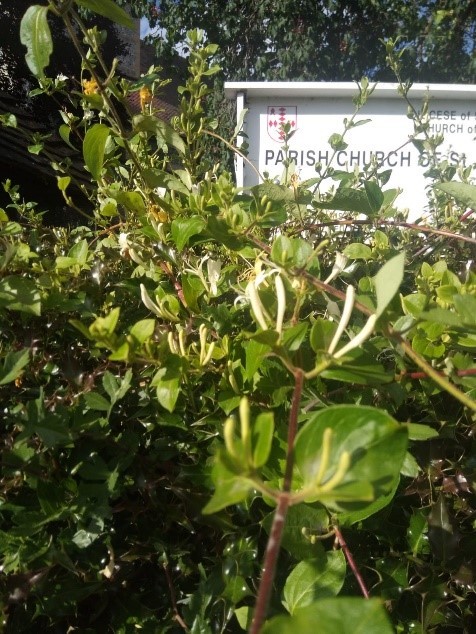
19th May
Bernard’s Blog No. 8
“Rough winds do shake the darling buds of May
And summer’s lease hath all too short a date;”
From Sonnet 18; William Shakespeare 1609
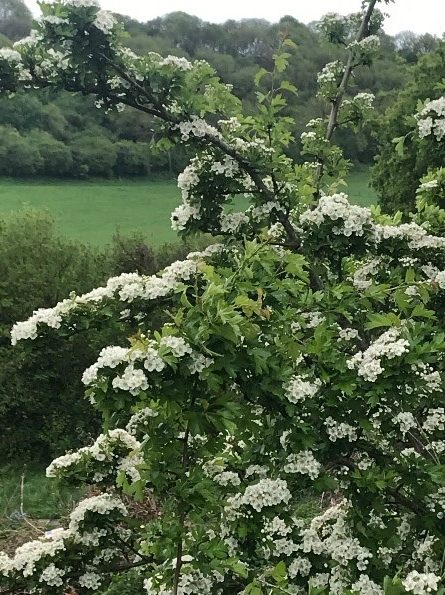
For a brief while the landscape is bathed with white May blossom from the hawthorn. The smooth and shiny, tooth margined lobes on the leaves are now adorned with dense fragrant clusters of flowers. Some flowers are infused with a subtle hue of rose, like the last drop of juice in a bowl of strawberries and cream. It is assumed that the gene causing this pink effect has been cultivated by growers to give the coral-flowered hawthorn cultivar beloved by town councils. The countryside trees are growing in thickets, hedgerows and at the edges of woods. It is also planted as windbreaks and boundary hedge.
The cow parsley is still screening and softening with foaming bluish -white flower lace, the raw edges of the hedges where they have been flailed, rising above the nettles and cleavers.
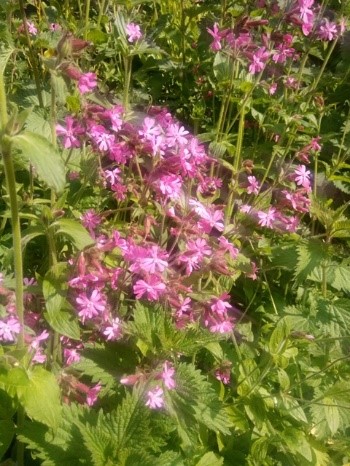
Now the view along the hedgerows is bursting with bold splashes of bright rose colour.
The Red Campion, (although more deep rose coloured) is springing up along the roadside and is interesting in that it is unisexual, having separate male and female flowers. Red campion interbreeds readily with the white campion and the offspring has, unsurprisingly, pale pink flower. They open in the evening when they are slightly scented to attract moths as pollinators.
Nest building and emerging baby birds are all around. The pair of Mallards, reported in an earlier blog, on the stream by the fish farm have reappeared with eight ducklings. It is happening all over the country and I imagine Millers Pond has its share too, together with tufted ducks and goslings. It is lovely to have the opportunity to see and watch these birds in Shirley and other nearby ponds. Where I am at present the only water fowl I have seen locally so far are the moorhens on the pond and the mallard family. The mallard, an ancestor of the farmyard duck, is the best known and most widely distributed. Ducks nest on the ground or in holes and there are three main groups: surface -feeding or dabbling ducks living in shallow water where they feed on water plants by upending and leap into the air to get airborne; Diving ducks dive from the surface for water plants and animals. Their legs are set further back so that they can swim underwater, and they run along the surface to take wing. The third group of ducks are sawbills, also divers.
The drake (male) has an unmistakable bottle green or purple head and white collar and a little curly tail. After breeding in the late summer, the ducks moult and replace their old worn out feathers with new ones. The males lose their bright body feathers and look similar to the brown females. At this time, having lost their wing feathers, they cannot fly and become very vulnerable to predators. This process is called Eclipse plumage, and is why in mid-summer it appears that all the drakes have gone. Once the flight feathers have regrown, the birds moult again and by October the full colours are back. The female quacks loud and hoarsely, the drake being restricted to a low murmur or a thin whistle, something you may notice in some human households.
Ducks by F W Harvey
When God had finished the stars and whirl of coloured suns
He turned His mind from big things to fashion little ones;
Beautiful tiny things (like daisies) He made, and then
He made the comical ones in case the minds of men
Should stiffen and become
Dull, humourless and glum,
And so forgetful of their Maker be
As to take even themselves – quite seriously.
Caterpillars and cats are lively and excellent puns:
All God’s jokes are good – even the practical ones!
And as for the duck I think God must have smiled a bit
Seeing those bright eyes blink on the day He fashioned it.
And he’s probably laughing still at the sound that came
out of its bill!
The swallow I saw earlier this month has now been joined by several more swooping to-and-fro after insects with their mouths gaping or swooping low to sip water from the fish farm or pond. I always marvel that a few weeks ago these tiny migrants were sunning themselves in the skies around southern Africa and have flown all the way here to raise a family this summer. Our other summer visitor has remained elusive until today. We wandered back through the woods hoping to see another deer or two, when the distinctive call of a cuckoo rang out. They are becoming rarer now and having spent his winter in the Congo he was determined to find a female who will go on to do her stealthy egg laying in the nests of other birds to be raised by foster parents. The adults will head back again in July, leaving their children to navigate alone to their winter quarters guided only by instinct and the Earth’s magnetic field. Incredible! We tracked the calls around the wood for a while and the persistent call was quite loud, but unfortunately, we didn’t see him.
I want to mention something however that amused me over the past few days which gives me a link*.

I have noticed over the past few years at St John’s how we regularly host families of Blue Tits in the gap within some of the flint faced wall at the east end of church. They may be there now! On our regular morning walk we pass a flint face building called “The Flintstones”, right opposite the fish farm. This building has a row of three decorative air-bricks with holes just large enough to allow access for a little bird. Each morning a constant coming and going through these vents are a large number of House Sparrows. They arrive like Exocet missiles and straight as a Van Gerwen dart but depart more cautiously as the little brown heads peep around before coming out like a cork from a bottle. Watching in anticipation is like waiting for a row of Cuckoo clocks to announce the time. That’s my link*
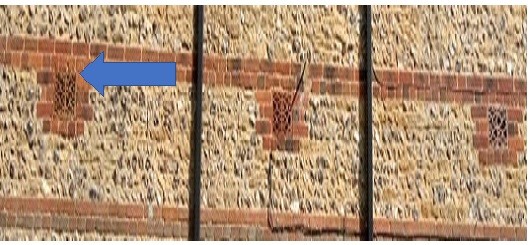
8th May
Bernard’s Blog No. 7
All creatures great and small…..
I sometimes wonder when I complete one Blog and think how/what/where on earth can I start another and I step outside and the words of John Galsworthy become appropriate.
“It was such a spring day as breathes into a man an ineffable yearning, a painful sweetness, a longing that makes him stand motionless, looking at the leaves or grass, and fling out his arms to embrace he knows not what.”
– John Galsworthy
Bertie the dog is keen to go on his usual morning ‘comfort break’ and I was hoping to go further afield to look for deer. It is now May and a glorious sunny morning and we start the ‘usual’ walk. As we pass the fish farm the trout seem to be even more lively than usual and the ‘plopping’ is more noticeable where the river is wider. The main chalk rivers of Dorset are ideal for Mayflies but you have to be there on one of the few days in May when they hatch to see the spectacle and we were lucky enough to see this on the River Winterborne this week.
Mayflies are common around freshwater wetlands, from fast-flowing rivers to still lakes, where the larvae spend their lives underwater, feeding on algae and plants. In the summer, the adults hatch out – sometimes simultaneously and in their hundreds; they have very short lives (just hours in some cases), during which they display and breed. Many species do not feed as adults as their sole purpose is to reproduce, dying once they have mated. Adult (winged) mayflies have no functional mouthparts and cannot eat. they have evolved to spend a year in the nymph form, taking on nutrients and growing, and then to pass on their genetics to a new generation in a very short period of time. The trout are very pleased to see them. Fly fishermen are aware of this and spend lots of time trying to tie feathers to hooks as clever imitation ‘flies’, to lure the trout onto their lines. Example below
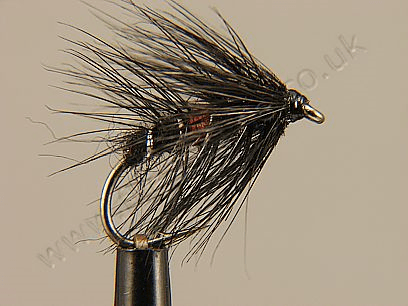
Ask Gerry Hobbs about this, he is an expert!
The Yellow Flag Irises are in bloom along the river bank and yellow seems to have become the in-colour for the area to where we are heading on our deer hunt
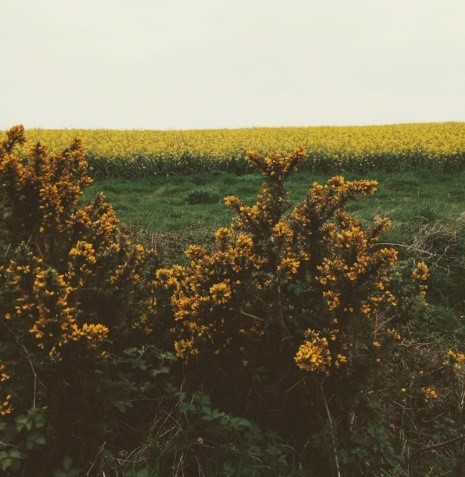
About half a mile away from our temporary home is an area of woodland with copses and scrubland bounded by agricultural fields. ‘Haydon Plantation’, Ideal deer hunting territory with a camera. The Gorse is in full flower, familiar to us on Shirley Hills where the spiny evergreen shrub with its golden, scented flowers are favoured by bees and dog walkers alike. On being touched by insects, the flowers explode pollen on to visiting insects.
Here the adjacent field has been planted with Rape joining the fashionable yellow theme we noted earlier today.
Making our way into the open woodland the terrain becomes more difficult with the tangle of growth underfoot and the uneven ground dotted with stumps. Not helped by one of us with short legs and another with dodgy hips but we were not in a hurry. We stopped to watch a Buzzard overhead soaring and seeking prey and looking like a small eagle but with a broad rounded tail. We had previously seen a buzzard from the garden, being mobbed by a group of crows, but here he was allowed to hunt in peace.
As we made our way deeper towards a copse there was movement from the groundcover and a deer slowly rose and looked in our direction. It had seen us before we saw him and we gazed at each other. I read up what to expect before we came out and realized it was too small to be a Red deer and too large to be a Muntjac. Fallow deer would have a longer tail and probably have a lighter colour with white spots. So, I had to decide between a Roe Deer or a Sika. I only confirmed its species when I got home.
It was our most common native deer, the Roe deer, it tends to be solitary in summer, but forms small, loose groups in winter. The males have relatively short antlers, typically with three points. They begin to grow their antlers in November, shedding the velvet from them in the spring. By summer, they are ready for the rutting season. After mating, they shed their antlers in October and begin to grow a new set. Roe deer live in areas of mixed countryside that includes woodland, farmland, grassland and heathland. They eat buds and leaves from trees and shrubs, as well as ferns, grasses and heathers.
A male roe deer is called a ‘buck’ and the female is a ‘doe’. Mating occurs in July and August, but females delay implantation of the fertilised egg until January of the following year, so that the young are not born during the harsh winter months. Two or three, white-spotted kids are born in May or June. This deer was joined by two others and they skipped away before we could get any closer pictures. Bruce, my son took the photo and the camouflage is good. There is more to venison than I realized.
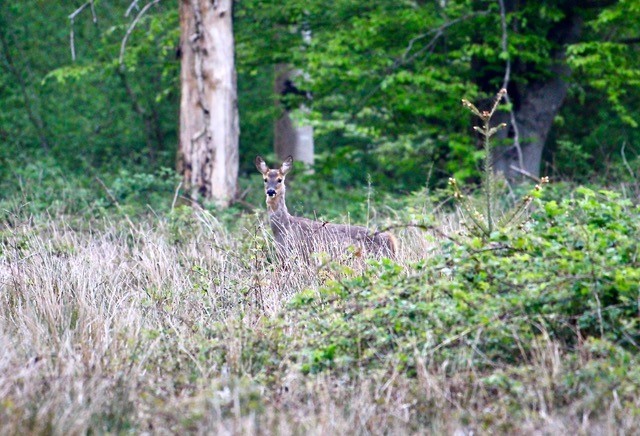
I started in a poetic frame of mind, let me finish in the same way:
“‘Tis like the birthday of the world,
When earth was born in bloom;
The light is made of many dyes,
The air is all perfume:
There’s crimson buds, and white and blue,
The very rainbow showers
Have turned to blossoms where they fell,
And sown the earth with flowers.”
– Thomas Hood
2nd May
Bernard’s Blog No. 6
The colours are gradually changing in the hedgerows and fields. Much of the vivid springtime yellow is being overtaken by an abundance of white. The Ramsons or Wild Garlic makes its presence known not only with lanes, hedges and fields of white spiky stamens but a strong garlic smell as you walk by them. Less prominent but with a similar name is the taller Garlic Mustard, sometimes known as “Jack by the hedge” with its heart shaped toothed leaves. Together with the Cow Parsley, White Dead Nettle, Wood Anemone, Hog weed, Stitchwort and many more I struggle to identify, white seems to be the colour. Even the fields so recently swamped with bright yellow dandelions alive with bees are now a sea of the familiar white ‘clocks’ of children’s games, and the trees are blossoming above us.
The mini heatwave over the past few days has brought out some more butterflies. Thanks to some guidance notes from Neil P. I can with more confidence tell you that there are definite Common Blues, the smaller Holly Blues, Peacocks, Large White and unmistakable petite Orange Tips (the females I discovered have black tips on the wings), both have mottled green and white underwings which helps them blend into the foliage when they are at rest with wings closed vertically above their backs, wonderful eye -fooling camouflage. Probable sightings include Small Heath, Wall Brown, Skippers, Small Tortoiseshell and other “little brown Jobs”! The Brimstones are certainly still around and it is them we have to thank for the word “Butterfly” it being a distinctively “butter-coloured fly” fluttering by. As summer approaches I will get even more confused but hopefully be home and asking Neil for a tutorial in the churchyard.
A short walk away and along a little incline there runs a path beside a horse’s field which leads to “Rose’s Orchard”. The trees are coming into blossom as the bees have discovered. Rose has put a few hives in the corner of the field and provides pots of local honey for the village. Not only that, Rose’s Cider has become legendary and it is marketed as “Cider by Rosie”
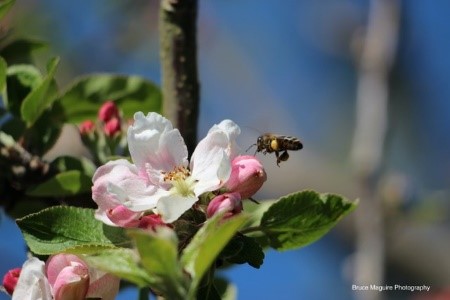
It is approaching the month of May but the usual Maytime festivities will not be taking place this year in Rose’s Orchard due to the Coronavirus. Usually a May Queen, ‘Toast the blossom’ drinks, music and a barbecue with cider. All usually low key as it’s a small village event but not happening at all this year.
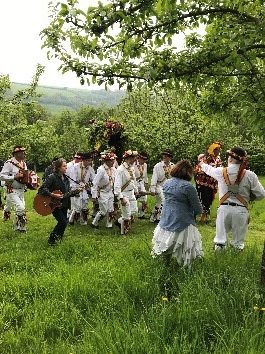
The birds and bees won’t worry, nature carries on. Our stroll along the bank of the stream offers some more activity in the water. Closer inspection shows fish amongst the water plants. Another puzzle for me, as if I didn’t have enough problems with butterflies. There is a local publication ‘The Valley News’ which helps me. It seems the Winterborne river at this point has become a haven for Rainbow Trout. These are not indigenous species, more likely escapees from the fish farm, but they are making the most of deeper, fast flowing water. We have just passed the spawning period and around the trout I spotted are scores of tiny fry (baby fish). The newly hatched trout are called alevins, and they live in the gravel, feeding off the remaining yolk that is attached to their body for 14 – 30 days, again temperature influencing their rate of development. Once the yolk has been eaten, the alevin become fry, emerge from the gravel, move towards the light and start to feed on tiny insects in the water.
Mortality rates at this highly vulnerable stage are very high. The fry are just a few centimetres long and consume a lot of energy, so they need to find food quickly, and plenty of it. They also become territorial – they want to be out of sight of other fry, so need habitat that has plenty of stones and plants to enable them to hide from the neighbours. And they are still very tiny, so they need shallow water (1 – 40cm) that isn’t too fast flowing.
The transition from living off the yolk to independent feeding is a critical life stage, and the one at which the majority of mortality takes place.
The mild and wet weather has encouraged the growth of Ranunculus fluitans, or as I mentioned in the last blog, Water Crowfoot (buttercup family) a month or so earlier than previous years. Ranunculus holds much beneficial nutrition for healthy rivers.
Back at the house we had been noticing an untidy pile of sticks and twigs on the thatched roof beside the chimney stack, some of which had slipped down the side. Our suspicions were confirmed when we watched a pair of Jackdaws coming and going. They were nest building in a warm, dry spot where one of the chimneys had been capped. They stayed for a few days but luckily seem to have moved on. If they had raised a family there, they may have stayed for a month. Jackdaws are smaller than rooks or other crows and can be recognised by a dark grey hood and pale grey glassy eyes and high pitched metallic tchack call, after which it gets its name. They have a jerky walk but are much quicker than the rooks. Like the other crows they are renowned as clever birds, ignoring scarecrows and farmers traps. They may store food for the winter and have been known to open snails by dropping them onto stones.
Much more delightful in the garden we were visited by a pair of Bullfinch. Although a British resident bird, I hadn’t seen Bullfinches for a long time. It is a shy bird, usually in pairs but this male was in the open showing his glossy black crown and blue-grey mantle and thrusting out his bright red breast like a Grenadier Guard. It is a small but bulky bird with a bull like head which, I suppose is where it got its name. The female is a much paler brownish pink. I’ve never heard it referred to as a “cowfinch”!
24th April
Bernard’s Blog No. 5
I think it was Emily Dickinson that wrote:
“To be alive is so amazing, there’s hardly time for anything else”
I know how she felt when I woke to bright sunshine and the morning bird song chorus today.
I’ve always had an interest in birdwatching, I would never describe myself as a ‘twitcher’. Any serious birdwatcher will take great exception to being called a twitcher. There’s a world of difference between the two. Birdwatching entails making careful observations about the birds one sees, even if it’s the most common, boring bird imaginable. Twitchers are only really interested in adding to the list of rare birds which they have seen.
Today our visitors from Africa have arrived. A slender dark steely-blue bird swooping in to its traditional perch on a telegraph wire. A swallow, chestnut-red throat and forehead and creamy white underparts his long -forked tail confirms what he is. I wonder how many more will be sweeping to and fro after insects over the coming days.
It is really busy with all sorts of bird life.The lack of vehicles makes the sound from the hedges and fields seem particularly loud when I rise in the mornings and is still there when I go to bed. One regular though can easily be overlooked. Often confused among the sparrows, it is the little Dunnock, its plumage is an inconspicuous streaky brown colour with a grey head and breast. It also has inconspicuous habits at is shuffles through the hedge or shrubbery, hunting for insects, worms or seeds. They are quite common in Shirley, often confused with the sparrows and are sometimes referred to as a ‘Hedge Sparrow’ but are, in fact, not sparrows but ‘Accentors’ and never seem to venture on a bird table.
By contrast a pair of what is arguably the most exquisitely coloured of our British birds has flown into the tree just in front of me. Goldfinches, with strikingly banded black, white and ruby-red head and brilliant gold and black wings. It is no wonder that the collective noun for a group of goldfinches is ‘a charm’. Our usual walk, be it in the morning or afternoon seems to manage to provide new sightings, even when not searching. As we are passing the fish farm the motionless figure of a grey heron is standing by one of the tanks. Not the most welcome visitor the owner has when it helps itself to a free breakfast, but the tanks are full and the heron, almost silently lifts himself effortlessly into the air to land again amongst the cows and calves in the field a short way off.
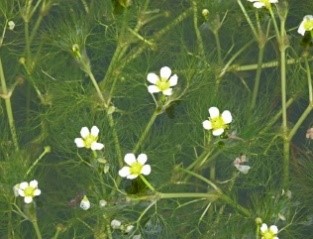
It rained yesterday and drizzled this morning and the little stream is filling again with water from the fields. As it drains through the chalk, the water is running quite fast but is crystal clear and sparkles as it dances over the stones on the river bed. I love bankside flowers but never usually take much note of the waterweed. Today however the stream is blanketed by a plant with submerged thread-like segments and leaves bearing masses of solitary, tiny white flowers. It is Water Crowfoot.
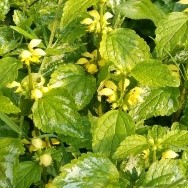
Over Easter week Jane sent me a photo she took in Selsdon of a Yellow Archangel plant.
I had been longing to see one last year when we did a survey of the wildflowers in St John’s Churchyard. An Archangel at St John’s would have made a great Newsletter report and Jane has found one in Croydon. There are lots in the hedgerows here.
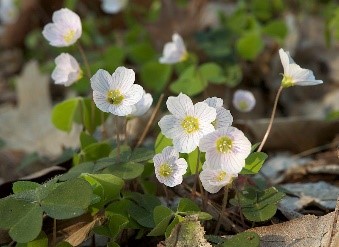
Christine also drew my attention to the Radio 4 programme “The Passion in Plants” broadcast at Easter which was written up in the Guardian and I am still searching for the Alleluia plant. It is the Wood Sorrel, called the Alleluia plant because it blooms between Easter and Pentecost when the psalms which end in ‘Alleluia’ are sung
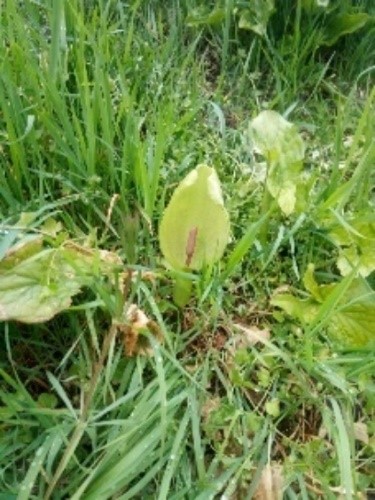
The Radio 4 programme also mentioned a plant I spoke about in Blog No. 1, The Wild Arum or Cuckoo Pint or maybe, Lords and Ladies, whose leaves are often speckled, said to represent the blood of Christ that fell when the plant was growing under the Cross.
I have since heard it called locally ”Jack in the Pulpit”. You may have heard other names but here it is showing its spadix exposed from its sheath. (botanical terms I assure you).
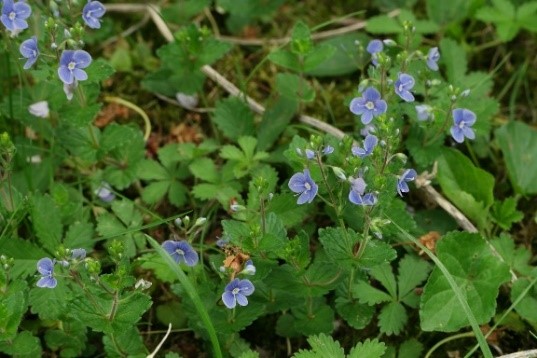
Another that appears at this season is the little, bright blue Speedwell also called ‘Veronica’, named after the woman who wiped Jesus’ face with her handkerchief on His way to Calvary. It was said the likeness of His face miraculously appeared on the cloth.
The Greek translation of ‘Veronica’ is Honest Image
14th April 2020
Bernard’s Blog No. 4
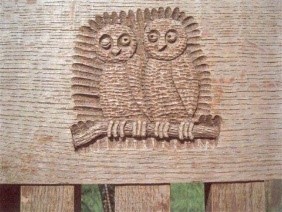
I’ve not heard an owl since I’ve been here but I am assured there are many residing, both tawny and barn owls. They breed early in the year and their hooting is less frequent at this time but there are a lot of owl images around the village. People born in the village are known as “Houghton Owls”, there is a story here that a villager got lost in the woods. When calling for help, she mistook the calls of owls for answering human voices, she followed the calls and they led her home. There is a theory here that Thomas Hardy used the story as inspiration for the scene where Joseph Poorgrass gets lost in Yalbury Wood in “Far from the madding crowd”. There are numerous signs around depicting owls, some on house names and some as models in their windows, others carved into the wooden benches in the village and within St Andrews church and even woven into some of the thatched roofs. Notice one owl is winking in the carving, but I’ve not heard a hoot yet.
This is a bird watching ‘twitcher’ paradise and the fine weather encourages me to take my time on my daily walk, today following the stream to the lower part of the village where there is an established fish farm.
Houghton Springs Fish Farm, the only source of farmed Arctic Charr but also the ’Winterborne’ rainbow trout strain. Usually supplying hotels and up-market restaurants, the coronavirus took away the market so the Danish owner has increased his takeaway service for ‘locals’ from cool boxes. The tanks of splashing fish have been established where there used to be watercress beds and a borehole supplies the farm and feeds the stream. It has become a visiting site of a pair of Mallard and a moorhen. The moorhen has been there every time I passed, identifiable by the red face shield and yellow tipped beak, green legs with red ‘garters’ and long yellow toes, lobed not webbed. The loud ringing ky-orrk picks him out and I wondered where his mate was. Today as I returned home there was a commotion behind some reeds at the village pond and a pair of them appeared putting the final touches, I assume, to their nest concealed by the bank. I look forward to seeing the shiny black chicks soon.
Around the tanks at the fish farm it is common to see one or two little egrets. These used to be uncommon vagrants when I was younger but are becoming more common now. Small snowy -white herons with long slender necks, with black legs and bizarre yellow feet conspicuous when they fly. They have long, thin, white, hanging plumes from their nape for which they were hunted.
The bluebell season seems all too short and the British bluebell is associated with ancient woodlands, something that is abundance here in Dorset. They are iconic, a favourite with the fairies and a sure sign that spring is in full swing. Just a short way behind the house there are woods managed by the Forestry Commission and today are carpeted in deep-violet blue. The flowers are unmistakable bell-shaped perennial herbs, six petalled with upturned tips. They droop to one side of the stem sometimes up to 20 on each inflorescence. Do not confuse these native British plants with the upright growing Spanish bluebells which flower around the stems and I am told, are not so popular with the fairies! There are countless folklore tales surrounding bluebells and in the language of flowers they stand for humility, constancy, gratitude and everlasting love.
I took some photos before I made my way home and to prove we were there Bertie and I were captured looking for blog material.
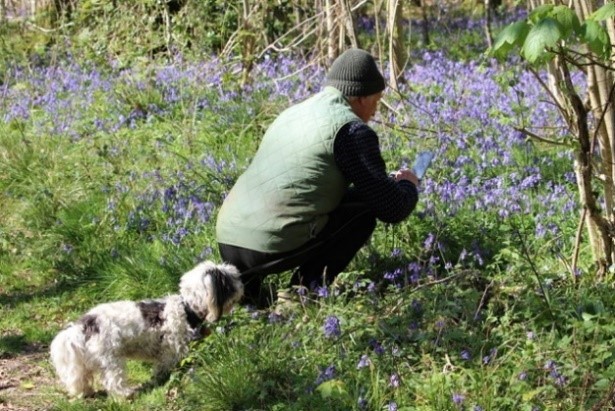
And, here is the resulting photo.
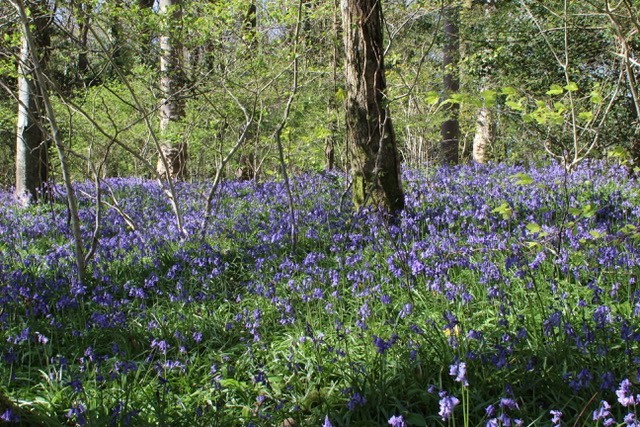
12th April 2020
Bernard’s Blog No.3
We saw a hare today.
Bertie and I took our daily exercise allowance in a different direction. We took a walk uphill until the road came to an end, then turned right up past some stables towards another village. A gorgeous view over the valley to our right and the hedgerows both sides twitching with birdlife nest building. Chaffinch was the busiest this morning too preoccupied to be worried by one man and his dog but birdsong all around as we climbed further up the road. The blossom in the hedge is beginning to shield some nests. It is on the blackthorn*. Easily confused with hawthorn which blooms about the same time. Both trees have creamy-coloured flowers with five petals and support hundreds of insect species. Blackthorn blossoms before its leaves appear, whereas hawthorn flowers after its leaves emerge. Blackthorn hosts one of our better-known berries: sloes. Around September onwards these blue-black fruits are about 1cm across and are used to flavour gin. They are also popular for making wines andpreserves. At the brow of the hill we stop to get our breath back and decide to return before we reach another county and pass a piggery on our left when suddenly there was a disturbance from behind the hedge. A hare! Larger than the rabbits we had seen earlier in the week bunny-hopping amongst a herd of cows. This chap was on his own and his longer hind legs and longer black-tipped ears gave him away as he moved across the farmland. No other humans in sight until we were nearing home when a man in a tractor came up behind us and kindly slowed down until we found a gap in the hedge to let him pass.
Back home we sat outside for a coffee and Bonio, I chose the coffee, and gazed across to the black birds circling the trees on the edge of the neighbouring farm. Quite a small flock and with untidy nests at the top of the trees beside St Andrew’s church assumed they were rooks. When they come closer and land, I can confirm they are rooks, they are distinguished from the carrion crows by their grey beaks, the bare patch at the base of the beak and throat and their baggy ‘trousers’. Whereas the crows hop, these rooks walk with a rolling gait rather like an onshore shanty man! The RSPB have a saying “if there is more than one crow, they are rooks. If there is only one rook it’s a crow”
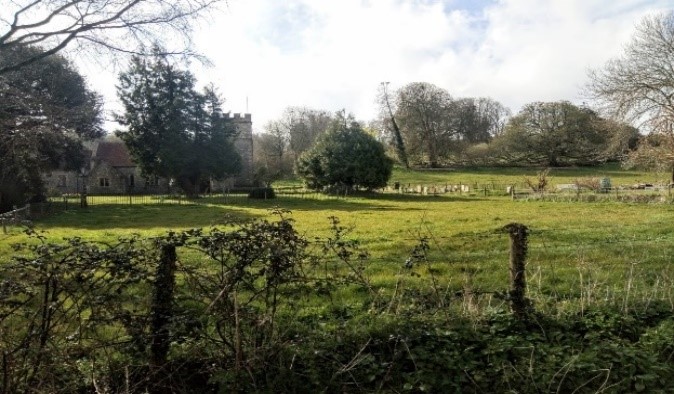
It goes without saying the noisiest bird in the garden today is one of our commonest British birds, the blackbird. Rivalling in persistence pheasants crowing from their covert, but the blackbird’s mellow, musical melody may end in a jarring screech. Have you noticed how they distinctively lift their tails over their backs when they alight?
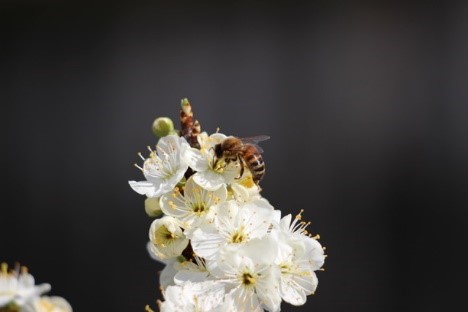
my son has seen this blog and sent me this picture he has just taken of a bee busy at work on the blackthorn.

1st April 2020
Bernard’s Blog No. 2
Another bright spring morning the birds are making their presence heard protecting their territory and trying to attract a mate. They time their breeding season to the warmest part of the year when there is plenty of food and lots of daylight in which to find it. As winter gives way to spring the longer light hours switch male songbirds into breeding song mode. It is the Robins and Blackbirds, what is that old saying about catching worms? But the Robins and Great Tits are now out. These smaller birds are more sensitive to cold and anyway the insects are up later and singing is hard work so it is the fittest, well fed birds that produce the strongest, most impressive song. Females therefore choose a mate that sings best because he is more likely to be good at raising chicks and passing on his genes.
There is a lot of activity under the thatched eves as a pair of great tits are constantly nipping to and fro. We hope they will raise a family there for a second year and we have managed to provide some fat balls upon which we are watching their feeding. There are a lot of musical additions to the morning chorus and they are abruptly interrupted by the harsh korr-kok of a male pheasant who, with a whirr of wings lands on the lawn like a chicken. Pheasants are reared in this area and they seem to know that it’s the closed season as four males arrived yesterday out of the hedgerow with two females (no sense of social distancing!). Their ancestors were Chinese, introduced in the 18th century and are really attractive. The males have a dark green and purple head, scarlet wattles round the eyes and usually a white (clerical?) collar. The plumage has a fiery copper colour. The female is a plainer less coppery – colour brown.
Bertie is agitating for his walk so I share my daily exercise allowance heading along the lane towards the small village pond. Ahead of me is an unmistakable pied wagtail with his black crown and sooty back and white bars on his wings. I often see these birds in Shirley recreation park or supermarket car parks and they do not worry about human company. Suddenly, however he is joined by a grey wagtail, a really beautiful bird, with its blue-grey head and back, sulphur yellow underparts and a contrasting black throat. It attracts its attention by the constant dipping of its very long tail before dancing off in a shuttle-cock flight in search of insects. They nest on fast flowing streams in the hills and visit ponds and streams so it is no surprise to find it here.
I am walking beside the Winterborne river, a little fast -moving stream really, but still carrying the flood water from the hills earlier this year. It has been explained to me that the origin of the name comes from the Bourne river appearing above the ground in this area at winter and drying up in summer. Hence the names of the villages, Winterbourne Stickland, Winterbourne Houghton, Winterbourne Kingston and several more. I am heading towards St Andrews Church in the centre of the village but, like all others, closed at present. Just beyond here at the time of the millennium the waterway was diverted to create a small village pond and won a Dorset design award. Loads more blog material here including these kingcups.
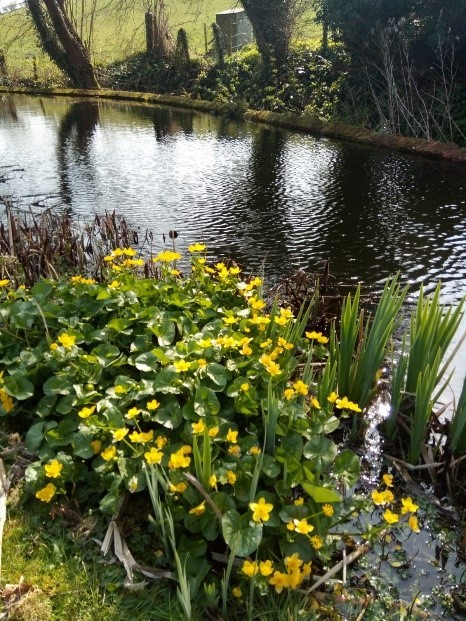
We return without meeting anyone else, just a wave to a man on a tractor. The sun is out and I promised to do some more weeding but I’m now distracted by a couple of butterflies. I’m not a lepidopterist but confident about the bright yellow male brimstone, they overwinter here and are one of the first to appear in spring. The other fluttering by confused me, the orange, black, yellow and white made me think it was a tortoiseshell. When it settled and opened its wings though the four “eye” shaped pattern suggested a peacock. Another overwintering butterfly whose colour pattern of the upper side possibly scares small predatory birds away. I wish my friend Neil was here to help me sort them out!
From the border emerges a fuzzy white -tailed bumble bee with its bright yellow bands. It is probably a queen who has emerged from hibernation possibly in an old mouse hole and sets about starting a colony by laying a few eggs that hatch as workers. They take over the building and foraging work. Males emerge later and mate with the new females who are prospective queens. The males and the old queen die in the autumn but the new queens hibernate.
Bernard’s Blog No. 1
Notes from Isolation
“Dad, at your age you’re in a Corvid ‘at risk’ group. We can self-isolate you in Dorset” I wasn’t given much choice and ended up with my family in a little hamlet near Blandford Forum. “you can bring Bertie”.
That was a week ago. Actually, I am in a village, a ‘hamlet’ does not have a church, there is one here, and a pub but unfortunately both have just closed. There are no shops but a few more thatched dwellings and we are near the top of a cul-de-sac. It is certainly isolated but absolutely delightful. My room looks out over the garden and Dorset countryside. A perfect location to watch nature evolve into spring and write about it to share, hopefully raising the spirits bringing a realization that God’s world exists despite Coronavirus and will be here for us all.
The birds are busy nest building. A male wren flying into the hedge with stalks of grass, doing a distinctive cocky tilt of the tail as he lands. The hedge is not yet in leaf but last year’s twigs give cover to his construction. He may well build other nests, which he will display to any female that enters his territory. If she likes this one more than the others she has seen she will move in, decorate and bear his children. Mind you he is no moral example. As soon as he has ensconced one female, he will try to tempt another into one of his spare nests, where she too will give birth to his progeny. The little bigamous bird will travel between his families raising both families.
The wild flowers are in abundance. Springtime yellow everywhere, the daffodils have reached their prime and are beginning to die back but the banks of primroses are competing with the celandines just as I imagine they are in our churchyard. Last year we spotted the first pink flowers of Lady’s smock, or cuckoo flowers in the churchyard. I imagine they are back as they are in the hedgerow here. Many wild flowers have local names and these are sometimes called milkmaids. ‘Cuckoo’ is often shared, whether it heralds the arrival of the bird I’m not sure but it is not to be confused with the swathes of wild arum which are filling the banks too, their shiny arrow headed leaves will soon be making way for the flowers surrounding the spadix which will eventually show through and in autumn the orange and green berries will give the plant other names, cuckoo pint or lords and ladies and other mor saucy country names which I won’t mention here.
Next blog more birds and butterflies.
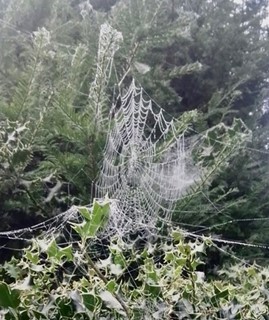
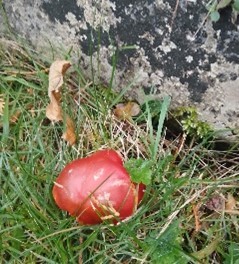
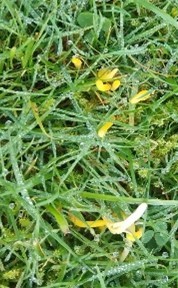
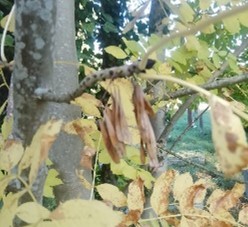
You must be logged in to post a comment.